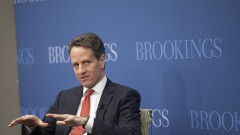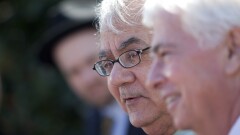In the decade since the crisis, the D.C. movers and shakers at the center of the crisis — and the government’s effort to stabilize the financial system — all moved on to new positions, from private attorney to movie industry lobbyist to a gubernatorial candidate. Here's a look at what they're up to these days.
Hank Paulson

Several years after leaving office in early 2009, Paulson went on to found the Paulson Institute, a U.S.-China relations think tank that focuses on economic growth and environmental sustainability. He serves as chairman of the group.
Tim Geithner

As Paulson's successor at Treasury under President Barack Obama, Geithner played a central role in the administration's efforts to stabilize and rebuild the financial system in the wake of the crisis. He was a key architect of the stress tests, which ultimately helped restore public confidence in the banking system. He also helped craft what would become the Dodd-Frank Act, Congress' primary response to the crisis. He stepped down from the position in 2013, following four years in office. He
Ben Bernanke

Bernanke is now a distinguished fellow in residence at the Brookings Institution, after leaving the Fed in early 2014. He also serves as a senior adviser to two investment firms, Pacific Investment Management Co. and Citadel. Like Geithner and others, he
Sheila Bair

Since leaving office in 2011, Bair has been one of the most outspoken in arguing
John Dugan

John Reich and John Bowman

After leaving the OTS, Reich is said to have retired. Bowman later entered private practice and is now a partner at the Dinsmore law firm.
Barney Frank and Chris Dodd

Dodd, a Connecticut Democrat, left the Senate not long after the passage of Dodd-Frank. In 2011, he was named the head of the Motion Picture Association of America, where he worked until late 2017. He is currently a senior counsel at the law firm of Arnold & Porter.
Frank remained in the House until January 2013. He now serves on the board of directors for Signature Bank in New York, and remains outspoken on financial services issues.
Robert Steel

In 2010, he was named deputy New York City mayor for economic development. He is now CEO of the global advisory and asset management firm Perella Weinberg Partners.
Neel Kashkari

After resigning from Treasury in 2009, Kashkari moved to a cabin in California, reportedly to “detox” from Washington. In late 2009, he became a managing director at Pimco, and in 2014 lost the California general gubernatorial election to incumbent Jerry Brown. Most recently, Kashkari has been the outspoken president of the Federal Reserve Bank of Minneapolis, where he has
Dan Mudd and Richard Syron

Since then, Mudd served for two and a half years,
Syron, meanwhile, retired to Massachusetts after the crisis. Like Mudd, he settled with the SEC in 2015 over charges he and other executives misled investors about Freddie’s condition (Syron also denied wrongdoing). Syron





